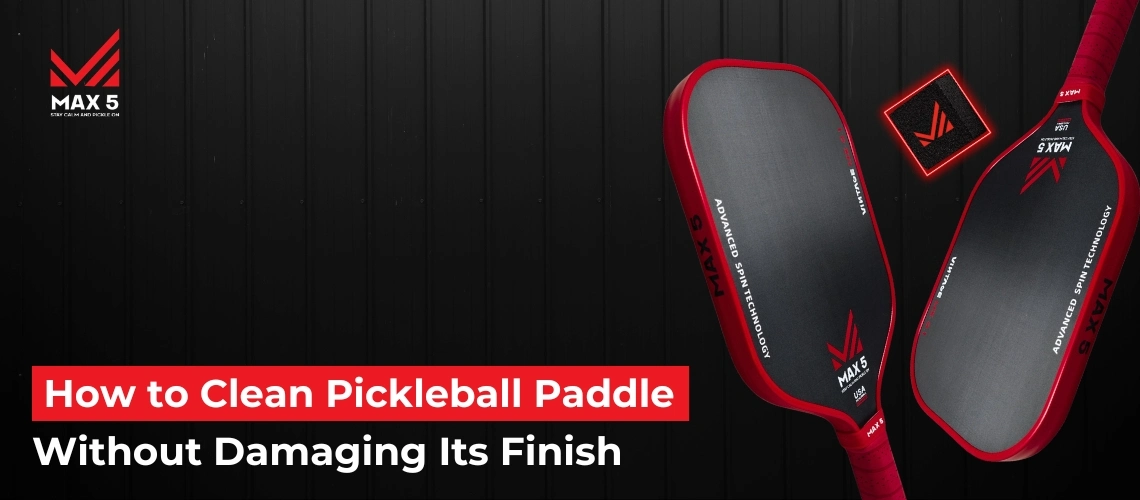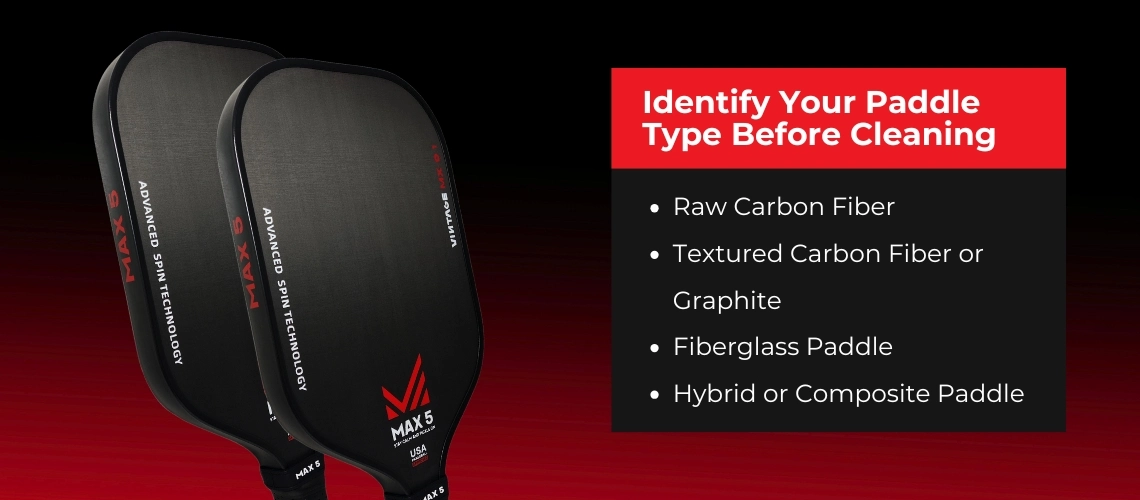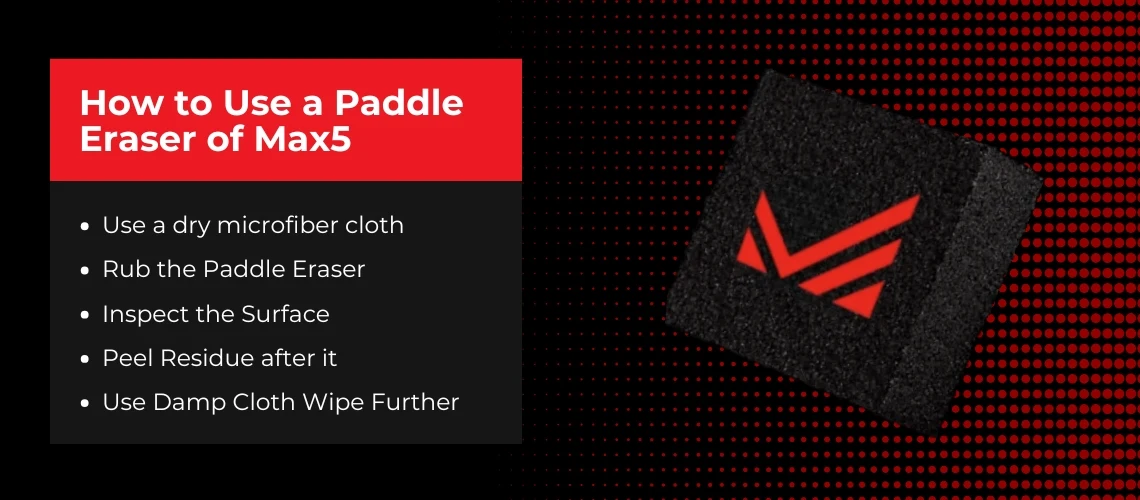
How to Clean Pickleball Paddle Without Damaging Its Finish
Why Cleaning Your Pickleball Paddle Matters:
It is important to know how to clean your pickleball paddle properly to ensure consistent play, particularly on more expensive paddles such as raw carbon fiber or hybrids. Your paddle face picks up dust, ball fuzz, and grime over time, which can wear down spin, dull the grip, and make your shots less controlled and precise.
This is the most common situation with carbon fiber textured paddles because the tiny particles get caught up in the weave. Similar to tennis players who restrung their racquets frequently. Pickleball players must be sure to regularly clean their paddles, not just when their game is at risk.
This guide will take you through the safe use of paddles for cleaning, such as erasers and cloths and soft solutions. Learn how to effectively remove carbon fiber, fibreglass, as well as composite paddles, without removing the grit or damaging the surface. This will ensure that your paddle is tournament-ready every moment.
Identify Your Paddle Type Before Cleaning
Before diving into cleaning, it’s critical to identify your paddle face material:
- Raw Carbon Fiber: Uncoated weave, prized for spin and control like a Max5 paddle.
- Textured Carbon Fiber or Graphite: Often has a protective coating, but it’s too slippery.
- Fiberglass: Durable but softer, may feature painted or grit-added surfaces.
- Hybrid or Composite: Mix of materials; may be textured, sanded, or grit-embedded.
Each type reacts differently to cleaning tools. For example, raw carbon fiber paddles collect more ball residue due to their natural weave. On gritty or outdoor courts, particles embed into these surfaces, reducing grip. So that’s why cleaning is needed for better performance.
Why does this matter? Because a dirty paddle can flatten spin, reduce ball dwell time, and compromise finesse. If your dinks are touchless or you lack top-spin drives, your paddle face is the problem.
Comprehending the composition of your paddle constitutes the initial step in selecting the appropriate cleaning method, thereby preventing any damage that may invalidate the warranty or impact gameplay.
What is Pickleball Paddle Erasers?
A pickleball paddle eraser is a dense rubber-like block designed to remove ball residue, dust, and dirt from paddle faces, especially raw carbon fibre models.
Brands like Max5 offer erasers specifically for this purpose. These resemble art gum erasers or rubberised sponge cubes, and they function by gripping onto grime embedded in the paddle’s weave.
How it works:
- When you rub the eraser on the paddle, it removes ball fuzz and dirt from the bumpy surface.
- It doesn’t require water or chemicals, ideal for carbon paddles.
They are inexpensive, light, and work for months. Many players report immediate improvements in spin and control after a quick wipe-down.
Make sure to use a paddle eraser only on compatible materials, typically uncoated carbon or Kevlar surfaces. For paddles with sanded or painted grit (often seen in fiberglass), paddle erasers might wear away the finish.
MAX 5’s Pickleball Eraser is engineered specifically for T700 raw carbon paddles, giving you pro-level cleaning without compromising texture.
Are Paddle Erasers Safe for All Paddles?
According to players on Reddit and popular pickleball forums, paddle erasers are widely accepted as safe but only for specific paddle types like raw carbon fiber and Kevlar weave models.
“It’s not an abrasive material only on the ‘raw carbon fiber’ style faces.”
“Raw carbon fiber is very sturdy; it’s not going to get damaged by soft rubber.”
These user testimonials reflect the broader sentiment across communities like r/pickleball, where dozens of players confirm that soft paddle erasers help restore grip without stripping texture. However, misconceptions persist, especially among new players or those with fibreglass or grit-sprayed paddles. Some engineering experts caution that frequent friction from erasers could wear surface grit over time, especially on painted or sanded textures.
Myth Vs Reality:
- Myth: Letting paddles soak
- Reality: Will warp or delaminate core
- Mistake: Using abrasive pad
- Reality: Scratches weaken surface
- Myth: Cloudy surface is OK
- Reality: It affects ball response clean immediately
- Mistake: Applying harsh chemicals
Reality: Can ruin protective coatings and void warranty
Pro Tip: Use erasers sparingly on non-carbon paddles and supplement with microfiber cloths for regular upkeep. Always check manufacturer guidance before applying cleaning pressure to coated surfaces.
Essential Paddle Cleaning Supplies Checklist
A streamlined kit for safe and effective paddle care:
- Soft microfiber or cotton cloths for everyday dust and residue removal
- Lukewarm water + mild soap gentle on all paddle surfaces
- 70% isopropyl alcohol wipes for grips, not surfaces
- Painter’s tape is optional, to protect logo/art
- Soft rubber cleaner block ideal for textured carbon (e.g. MAX 5 Paddle Eraser)
- Leather cleaner/conditioner for leather grips
- Dry towels & paper towels for final drying
- USAPA-endorsed pickleball even bounce ready to play
Tip: Using a carbon-specific eraser block restores grip without stripping texture – perfect for raw carbon paddles.
Comparison Table: Paddle Cleaning Methods
| Method | Best for Paddle Type | Safe? | Frequency | Key Benefit |
| MAX 5 Paddle Eraser | Raw Carbon (T700, uncoated) | Yes | Daily | Restores spin & grit |
| Microfiber + Water | All Types | Yes | Weekly | Safe, non-abrasive wipe |
| Mild Soap Solution | Fiberglass, Graphite, Hybrid | Yes | Weekly | Removes sweat & oils |
| Alcohol Wipe (70%) | Leather & Synthetic Grips Only | Yes | Weekly | Degreases sweaty grips |
How to Use a Paddle Eraser (Step-by-Step Daily Routine)
To maximize performance and protect your paddle, follow this step-by-step guide for cleaning with a paddle eraser:
- Dry Wipe: Use a dry microfiber cloth to remove loose dust or grit gently.
- Eraser Strokes: Rub the paddle eraser in straight lines across the face. Apply light pressure, don’t press hard or scrub in circles.
- Inspect the Surface: Look for any remaining spots of dirt or ball residue. Focus eraser strokes there.
- Peel Residue: When the eraser accumulates black or grey residue, it is advisable to peel off the top. This helps maintain its tackiness.
- Optional Damp Cloth Wipe: For extra cleaning, follow up with a slightly damp cloth, especially if the paddle looks hazy.
- Full Dry: Dry the paddle completely before putting the paddle inside your paddle bag.
Pro Tips:
- Clean after every outdoor match or gritty court play
- Don’t use household cleaners, as they may react with coatings.
- Store your eraser in a sealed pouch to prevent dust buildup.
Daily use of a paddle eraser revitalises spin and maintains paddle feel, particularly in competitive match play. For daily maintenance, the MAX 5 Paddle Eraser offers tack-restoring cleaning tested on the Vintage MX0.1 Red & Black series. Players report better spin feel in just one pass.
Deep Cleaning Method: Weekly Paddle Maintenance
A. Quick Wipe Routine
- Dry-wipe surface after every use removes dust and sweat.
- Clean grip with a cloth, use alcohol if oily.
B. Weekly Deep Clean
- Mix lukewarm water + 2 drops of mild soap
- A damp cloth never soaks paddles
- Wipe front, back, and edge guard
- Rinse the cloth; wipe again
- Dry thoroughly upright
C. Monthly Advance Care: Carbon Fiber Specific
- Use MAX 5 Paddle Eraser: gentle circular rub over surface
- Remove residue with dry microfiber
- Light buffing restores ‘tack’ and removes swirl marks
D. Fiberglass Paddle Care
- Fiberglass shows wear faster stick to mild cloth wipes
- Use eraser sparingly
- Avoid deep scuffs or edge damage
Grip Cleaning Tips for Leather and Synthetic Paddles:
- Synthetic grips: soap + water or alcohol for sweat/oil
- Leather grips: use leather cleaner, then conditioner
- Keep slightly damp for tack not overly wet
- Replace annually or whenever the surface feels slick
Alternative Cleaners for Non-Carbon Paddles:
If you have a fibreglass, composite, or coated paddle, use more delicate cleaning methods:
- Microfiber + Warm Water: Suitable for cleaning surface dirt without scratching grit or coating.
- Gentle Soap Solution: Combine warm water and a few drops of mild dish soap. Dip a cloth, wring, and clean gently.
- Homemade Cleaner: Equal parts of vinegar and water can dissolve grime and oily deposits removed with a baking soda paste.
- Baby wipes or antibacterial wipes: They are a handy choice for an instant touch-up, especially on grips, on-court.
Never soak your paddle or use abrasives. Don’t use strong cleaners such as alcohol, chlorine, or bleach that remove coatings or weaken adhesives.
These are suitable for overall cleaning, but they will not capture deeply embedded dirt, such as a paddle eraser on uncooked carbon.
Impact on Spin and Performance after Using Eraser
Regular paddle cleaning isn’t just about looks; it directly impacts your game.
A clean paddle face restores the micro-grip needed for top spin, slice, and control. Many players on Reddit report noticeable improvements after using a paddle eraser, especially on textured carbon surfaces.
While scientific tests on spin gain are limited, anecdotal evidence is strong: users feel their paddle “grabs” the ball better post-cleaning. That tactile feedback often translates to more confident strokes.
If your paddle feels dead or slippery, a quick eraser pass may revive its bite, especially helpful for power hitters and spin-based play.
Cleaning & Maintenance Routine
For optimal results, clean your paddle based on play frequency and court surface:
- After each outdoor session (sand, grit-heavy courts)
- Weekly for recreational or indoor play
Also:
- Change grips regularly especially if they feel slick or collect sweat
- Wipe grips with antibacterial wipes after matches
Storage tips:
- Always store in a dry paddle case
- Avoid leaving in humid garages or near moisture
Maintenance isn’t just about the face. An adequately maintained grip improves paddle handling and overall confidence on the court.
Conclusion:
Keeping your pickleball paddle clean isn’t complicated, but it is critical. Whether using a paddle eraser or microfiber cloth, your goal is to restore grip, preserve texture, and game-ready spin. Play with raw carbon fiber? Get a quality paddle eraser today.
Check out the MAX 5 Paddle Eraser and explore the Vintage MX0.1 paddles made with T700 RAW Carbon, available in Red and Black.
Complete your kit with MAX 5 Optic Green Balls (3-pack & 6-pack) USAPA approved.
Frequently Asked Questions
Will paddle erasers damage my paddle?
Only if used on painted or grit-coated fiberglass paddles. Safe for raw carbon.
How do I compare carbon fiber with graphite?
Carbon feels matte or textured; graphite is often smoother or glossier.
My eraser leaves black smudges. Why?
That’s residue buildup. Peel the top layer or wash with mild soap.
How much pressure should I use?
Light pressure. Avoid aggressive scrubbing that could damage the face.
When should I stop using my pickleball paddle?
When the paddle looks clean and feels grippy. Over-cleaning can wear surfaces.


